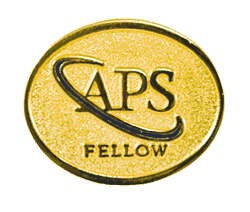Dec 6 2012
Five University of Wisconsin-Madison researchers are among about 250 newly named fellows of the American Physical Society, an honor bestowed upon no more than half of one percent of the professional society's membership.
 APS Fellows pin
APS Fellows pin
The peer-awarded designation is given in recognition of significant research advances or innovative contributions in the application of physics to science and technology.
UW-Madison's new fellows and their citations from the American Physical Society are:
Robert H. Blick, Lynn H. Matthias Professor in electrical and computer engineering, chosen for his distinctive contributions to the physics of quantum dots and nanomechanical systems, and for his fine contributions to developing new on-chip screening methods for ion channel spectroscopy and mass spectroscopy of proteins.
Sridhara Dasu, professor of physics, selected for his leadership in understanding the mechanism of electroweak symmetry breaking in proton-proton collisions, contributions to studies of flavor-changing neutral current electro-weak decays of the B-meson, and innovation in triggering, data acquisition and computing in particle physics experiments.
Daniel J. Den Hartog, senior scientist in the Department of Physics, cited for novel advances in and applications of optical and spectroscopic plasma diagnostic techniques in different magnetic configurations, and for critical experimental contributions in understanding magnetic self-organization in the reversed field pinch.
Mark A. Eriksson, professor of physics, noted for contributions to the understanding and development of nanodevices for spintronics and quantum information applications.
Alex Lazarian, professor of astronomy, chosen for diverse contributions to the theory of magnetized turbulence and its application to the interstellar medium. He has pioneered the study of fast reconnection in turbulent fluids and discovered the role played by small spinning dust grains in the cosmic microwave foreground emission.